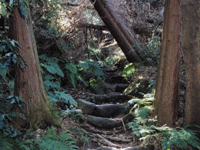Another Kamakura
Back to Contents of Issue: April 2005
|
|
|
|
by Burritt Sabin |
|
 Kamakura brings to mind the Great Buddha and temples, boutiques and bistros on Komachi-dori, torii gates and cherry blossoms. Yet its genius locus, predating temples and hordes of tourists, is darker. Kamakura traces its origins to Minamoto no Tomoyoshi. This warrior, on his way to subdue the rebellious Abe clan in the north, stopped at Kamakura and dedicated a shrine to the Minamoto tutelary deity, Hachiman, the god of war. Kamakura brings to mind the Great Buddha and temples, boutiques and bistros on Komachi-dori, torii gates and cherry blossoms. Yet its genius locus, predating temples and hordes of tourists, is darker. Kamakura traces its origins to Minamoto no Tomoyoshi. This warrior, on his way to subdue the rebellious Abe clan in the north, stopped at Kamakura and dedicated a shrine to the Minamoto tutelary deity, Hachiman, the god of war.
The association with his ancestor was a reason Minamoto no Yoritomo established his military government in Kamakura in 1185. Another reason was the city's being a natural fortress, facing the sea and encircled by hills on three sides. But the engirdling hills impeded transportation, for which reason the Kamakura government had paths carved from hilltops. Four such paths, called kiri-doshi, were hewn, and together with three slopes were called the Seven Mouths of Kamakura. The oldest is the Nagoe Kiri-doshi. It debuts in history in 1233, with a reference in the Mirror of the East. However, its origins are obscure. It has fallen into disuse. Which is good. Untrammeled the path has retained its old contours. I decided to walk the Nagoe Kiri-doshi. From Kamakura Station I took a bus bound for Zushi via Nagoe and got off at Chosho-ji. I climbed a concrete road past houses on the left. Dosojin, guardian deities, saw me on my way.  I knew when I reached the Nagoe Kiri-doshi, for the way narrowed to a stepped nearly shoulder-wide path between walls of ferny, moss-covered rock in the grip of roots. Only birdsong broke the silence, and the periodic bell of a railroad crossing, long ago the knell for the Nagoe Kiri-doshi. The path doglegged right into a copse of cedar. So steep was the mountain the trees grew nearly parallel with the ground. Shafts of light between them dappled the earth a chiaroscuro pattern. All was brown and green save for the red berries of laurels and the pink blossoms of winter camellia. Some cedars had been felled by typhoons, and I ducked under the vine-garlanded windfall. Soft underfoot felt the leaf-strewn path near the summit. Here a rock sat in the middle of the path. No object for contemplation of the Zen devotee but rather, perhaps, an obstacle to invasion. I knew when I reached the Nagoe Kiri-doshi, for the way narrowed to a stepped nearly shoulder-wide path between walls of ferny, moss-covered rock in the grip of roots. Only birdsong broke the silence, and the periodic bell of a railroad crossing, long ago the knell for the Nagoe Kiri-doshi. The path doglegged right into a copse of cedar. So steep was the mountain the trees grew nearly parallel with the ground. Shafts of light between them dappled the earth a chiaroscuro pattern. All was brown and green save for the red berries of laurels and the pink blossoms of winter camellia. Some cedars had been felled by typhoons, and I ducked under the vine-garlanded windfall. Soft underfoot felt the leaf-strewn path near the summit. Here a rock sat in the middle of the path. No object for contemplation of the Zen devotee but rather, perhaps, an obstacle to invasion.
I took a side path that angled upward to a flat clearing semi-ringed by trees from which hung vines like Spanish moss on an oak in South Carolina. In the center stood a monument to the unknown dead. On the circumference sat an animal crematorium. I peeked inside, and shuddered. There was the skull of a dog. Two feral cats eyed me warily from a patch of sunlight. The clearing would have afforded the Kamakura army a prime place to lie in wait for an enemy climbing the kiri-doshi below. Indeed, after the death of Yoritomo in 1199 and the creation of the Hojo Regency, the greatest threat to the Kamakura Shogunate was the Miura clan. The Nagoe Kiri-doshi lay on the route from their Kinugasa Castle to Kamakura. From the summit the path winds between sheer walls of rock where an enemy would have been vulnerable to ambush. A side path to the former site of the Mandala Hall was closed. A sign explained that it was undergoing a years-long archaeological investigation. So I didn't see the many yagura, graves in hillside cavities, where the dead were laid because of the lack of flatland in Kamakura. The many yagura are one reason why the Kotsubo Tunnel dug through the base of the mountain is said to be haunted. People with an interest in paranormal manifestations or young people seeking spine-tingling thrills as respite from sultry midsummer evenings were wont to brave the tunnel and then climb the mountain to the medieval graves. The path led to Kotsubo where many years ago my dog had attended obedience school and a friend still lives. I dropped by. His wife whipped up fried rice and egg. It was a relief to be off my feet in the world of the living |
|
Note: The function "email this page" is currently not supported for this page.





